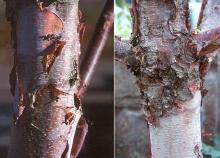Betula utilis var. albosinensis
Common name:
Chinese Paper Birch,
Chinese Red Birch
Pronunciation:
BET-u-la EW-til-is al-bo-si-NEN-sis
Family:
Betulaceae
Genus:
Synonyms:
Betula albosinensis
Type:
Broadleaf
Native to (or naturalized in) Oregon:
No
- Deciduous tree, 40-60(80) ft [12-18(24) m], rounded habit. Leaves alternate, simple, ovate to ovate-oblong, 5-7.5 cm long, about 3 cm wide, margin doubly serrate or occasionally even slightly lobed, base rounded or subcordate, apex acuminate, dark green above, paler and glandular below, 10-14 vein pairs; petiole 7-20 mm long; foliage yellow in fall. Bark rich orange-red or orange-brown, peels off in very thin sheets, under layer coated with a white bloom.
- Sun to part shade, best in moist well drained soil.
- Hardy to USDA Zone 5 Native to central and western China.
- albosinensis: white, of China septentrionalis: Northern, a reference to a group of seven stars that are circumpolar in the night sky in the northern hemisphere known as the Big Dipper (US) or the Plough (Ireland, UK).
-
The botanical variety, Betula albosinensis var. septentrionalis (Northern Chinese Red Birch), is normally taller than Betula albosinensis, to 115 ft (30 m), has orange-brown to yellow-orange or orange-gray bark persisting on the trunk, young shoots are glandular, and leaves obovate to oblong-ovate, 5-9 cm long, the underside has silky pubescence on veins and axillary pubescence (Krüssmann, 1976). This variety was given a "Great Plant Picks" designation for Northwest Gardens (www.greatplantpicks.org). Some indicate that var. septentrionalis is rarely encountered in the (U.S.?) nursery trade (Dosmann, Amer. Nur. Apr. 15, 2002), whereas Jacobson (1996) states that the species is "scarcely ever grown" and that var. septentrionalis is uncommon and sold mostly by Canadian nurseries. Furthermore, he says that trees offered under name of B. albosinensis may be intermediate with "typical B. albosinensis" and with hybrids of B. pendula. Dirr (1998) indicates that Chinese Paper Birch are encountered infrequently in the U.S. but are common in European gardens. This latter point is also suggested by the number of selections listed by Royal Horticulture Society, for example:
- Betula albosinensis 'Bowling Green', 'China Ruby', 'Chinese Garden', 'K. Ashburner', 'Kansu', 'Ness' ('Fascination' and 'Hergest" are listed by others).
- Betula albosinensis var. septentrionalis: 'Purdom'
- Taxonomy: Currently Betula albosinensis and Betula albosinensis var. septentrionalis are considered var. or subspecies of Betula utilis or even a synonym of this species. Betula utilis is widely spread across Central Asia, from Kazakhstan through Afghanistan and the Himalayas of Pakistan, India, Nepal, Bhutan to central China. It is a very polymorphic species as regards the shape and the number of veins of the leaf, size of the male catkins and the nature of the fruiting scale, which gradually change from the Western to the Eastern limit of its distribution range. Some consider this to be an aggregate species. There is so much variation in the different parts that it merges into Betula utilis and it is hard to separate these from one another (Flora of Pakistan).
- Silverton, Oregon: The Oregon Garden.



